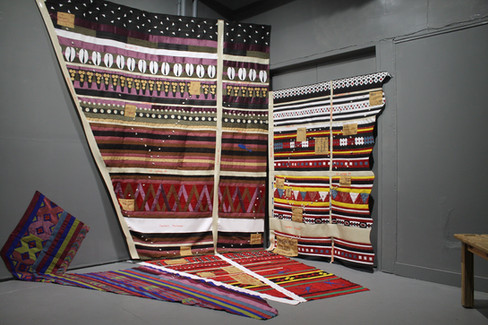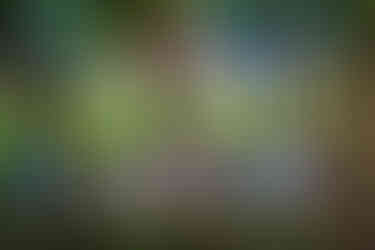Inside the Studio: Ronen Gamil
- Art Dealer Street
- 7d
- 7 min read
Brooklyn-based, Yemeni-Israeli artist Ronen Gamil builds environments that ask us to look again at what we call home—for people, for plants, and for the animals that move among us. Trained in studio art and urban planning and seasoned by a decade in public horticulture, Gamil stitches together materials and research: copper wire and beads, aluminum cans, welded steel, luminous textiles, and field notes on shrubs, bees, and birds. The results are immersive installations and drawings that read like living maps—Crown Heights traced in Yemenite embroidery patterns; threshold corridors of fabric that choreograph the friction and hope of border crossing; diagrams of subterranean bee housing that mirror human apartment systems. His palette is bright, even playful, a deliberate “welcome mat” laid over heavy themes—gentrification, extractivism, displacement, and the shifting routes of migration across species. In this in-depth Inside the Studio, Gamil guides us through a practice grounded in interspecies ethics and community scale, where color seduces, materials testify, and research becomes form. Enter his worlds; let the questions linger after you leave.

Read on to learn more in an exclusive interview with Ronen Gamil :
Your practice addresses interconnected issues like affordable housing and wildlife habitat. You mention focusing on “affordable housing for humans, habitat for non-human animals, and migration experiences.” How do you integrate these urban and ecological concerns into your art, and can you give an example of a piece where these themes intersect?
I investigate analogous dynamics for human and non-human animals as “parallel interspecies commonalities”.
By recognizing that different species merit care and attention, I enact an “equality of priorities”.
There is a continuum of processes affecting both humans and non-human animals. These include displacements, habitat destruction, natural material extractivism, real estate speculation as an extractive capitalist process tearing through communities, climate refugees, extractive geopolitical interests leading to war migrants, and more.
The drawing Subterranean Bee Housing System references a networked system for an apartment building. On another pictorial level, the drawing references a subterranean housing system for solitary mining bees who are aggregated as separate families. Up to six hundred separate families use the same main entrance to the dwelling complex.

Your artist statement mentions drawing connections between “the plights of both human and non-human animals” and blurring established hierarchies. How do you embody this idea in your installations, and why is it important to you?
As a garden ecology horticulturist, I farm for wild insects, birds, and small mammals. My first installations were planting such as Bartel-Pritchard Entrance Planting Design. Centering non-human species blurs hierarchies.
The drawing Site-Specific 00001: House Wren feeding + Osmia Mason Bees + Calliopsis Mining Bee + Red Spotted Purple Caterpillar + Viceroy Caterpillar hosted by a Serviceberry shrub centers non-humans where a shrub is a place of multi-species encounters, offering essential foods.
These topics express interspecies solidarity and conditions of being vulnerable to extractivism and capitalism in a broad sense as I touched on earlier.
In the sculpture Bee Miner, my identity as a Yemeni Jew in solidarity with Palestinians and notions of belonging intersect with the ecological context of the Eastern Mining Bee.

In your 2020 exhibition The Best Is Yet to Come, you created a textile collage that weaves together traditional Yemeni-Jewish garment patterns with maps of gentrifying Crown Heights developments. How do your cultural heritage and urban-planning background intersect in this work, and what message were you hoping to convey?
My Yemenite identity involves multi-generational systemic discrimination, mockery, trauma, and zionist state violence, where SWANA Jews (Southwest Asia North Africa) have been treated as a marginalized or lesser community within Israeli society. Crown Heights as a place of luxury residential real estate speculation, propels the double edged sword of gentrification and displacement. I express affinity by merging patterns from my ethnic group with neighborhood maps, marking sites of new construction.
My urbanism graduate studies intersect with the centrality of land use practices.
The second message is that heavy police presence plays a role in social control, generating favorable conditions for investors. Third, through comparison to other neighborhoods, I express the shifting new frontier for capital accumulation through real estate speculation.

Your installation Threshold required visitors to double back through fabric barriers, metaphorically illustrating the obstacles immigrants face in reaching and settling in a new place. What inspired you to design this immersive experience, and what do you hope audiences take away from moving through it?
The installation Threshold was for Brooklyn Public Library’s Open Air University where migrants taught their expertise subjects, in a period of tremendous assault on migrant rights and dignity from the federal government. To create tension between a “visual proclamation of a protected zone”, I evoked surveillance, referencing points of entry into state territories.
I hope audiences of Threshold think about international airports and the asymmetry of access to resources based on a person’s passport. This dovetails with frameworks of the global north as fortressed jurisdictions, mounting barriers for people’s aspirations. I expressed that most migrants arrive to establish a stable life, to acquire quality education, and rewarding work. I used colors, patterns and textures to celebrate richness in ethnic diversity.

You often use bright, playful colors in stark contrast with heavy themes—“playfully misleading audiences to grapple with unpleasant, uncomfortable realities.” How does this visual strategy affect the way viewers engage with your work, and what do you hope they feel when encountering this contrast?
Viewers receive both visual stimulation and an invitation to engage with the subjects raised by the project in question. Viewers have the option to get involved with the project intellectually, and think through ethical issues, social, or environmental concerns.
I hope viewers will have an experience that is contemplative, gradually settling into the deeper meaning of the work, diving and getting into a reflective, psychological mental space of thinking about the conditions of certain social groups and non-human animals. I also hope that work affords a place for audiences to have a moment with these important concerns for a healthy society and planet, and a setting to feel profound connections to the topics raised through the art project.
Having grown up as a Yemeni Jew of color in Israel and later lived in New York, you’ve spoken about experiencing racial and social hierarchies firsthand. How do those personal experiences with migration and identity inform the stories you tell through your art?
I quote Yemenite embroidery in The Best is Yet to Come. Bee Miner pays tribute to Yemenite silversmithing. In Prohibited versus Protected Species in the Bio/Necropolitics of Palestine-Israel, I borrow Yemenite silversmithing patterns to express that Yemenites take part in the horrors of the continuous Nakba (catastrophe in Arabic), inflicting the Palestinian tragedy. I express an affinity with Palestinians, as a person of Arab Jewish origin.
At the intersection of migrant and Arab identity is my solidarity with Palestinian predicaments, and of not having a home or place of full belonging. This connects with empathy for unhoused individuals. Home(-) and Garden references unhoused persons in public parks, outside of formal housing markets.
Many of your installations transform entire environments. For example, you built “twenty-four miniature tents” collaged from aluminum cans to create a neighborhood map. How do you approach designing these large-scale, site-specific installations, and what role do the chosen materials (like metal and fabric) play in shaping the audience’s experience?
Training and work in architecture, art, urbanism, horticulture, and traffic engineering inform these designs, as do immersive gardens with plants of various heights, textures, colors, and fragrances.
In Home(-) and Garden drinking-cans communicate that various low income groups collect them for five cents – they become a currency, as curator Jess Wilcox observed.
In The Best is Yet to Come fabrics reverse exterior and interior, situating audiences between tapestry-like surfaces. Fabrics summon the home as a temple, but also as a commodity, where the sanctity of the home is desecrated through ruthless housing markets that evict, displace, render homeless, leading to destitution, misery, illness, and death.
In Threshold fabrics generate tension between hard and soft barriers, between national borders and ethnic diversity, as a place of warmth, celebration, dignity, pride, rootedness, and ancestrality.
Looking ahead, are there new themes, materials, or collaborations you’re excited to explore in your future work? How do you envision your practice evolving in response to current social and environmental challenges?
I will create work about my Yemeni identity in relation to Palestinian liberation. I will develop new pieces addressing Zionism and its negative consequences for people like me. As Palestinian scholar Edward Said and Iraqi Jewish Israeli scholar Ella Habiba Shohat each titled their respective articles. I look forward to having the opportunity for a short residency in late October 2025 and a four-person exhibition at Materials for the Arts (MFTA) in Queens, NY planned for January through March, 2026.

Spending time with Ronen Gamil clarifies how an artwork can be both a site of pleasure and a site of study. Across this conversation, several threads bind the practice: an “equality of priorities” between human and non-human life; a cartography of housing and habitat attentive to land use and community; and a material intelligence that turns fabric, cans, wire, and plants into evidence. Color functions as a soft threshold—inviting viewers closer before rerouting them toward slower reflection. Craft lineages—Yemenite silversmithing and embroidery—anchor the work in memory while opening it to solidarities built through care, observation, and shared space.
Looking ahead, Gamil’s focus tightens: new projects will extend these inquiries through drawing, sculpture, and immersive installations, alongside forthcoming presentations including a short residency and a four-person exhibition at Materials for the Arts (MFTA) in Queens, NY (Jan–Mar 2026). We invite you to carry his questions into your own neighborhood: Who gets to stay? Who else lives here—unseen, unheard? And what might a just habitat look like across species?
You can learn more about Ronen Gamil and his work via these links:
Website: @Ronen Gamil Instagram: @ronengamil
















